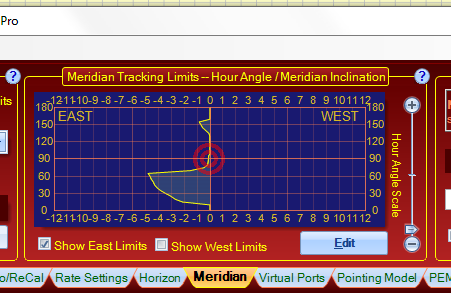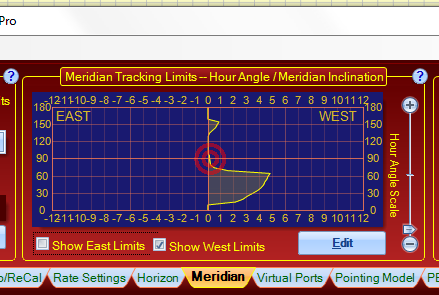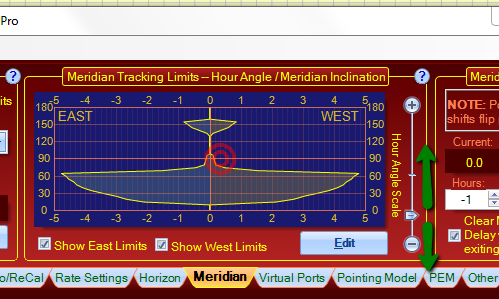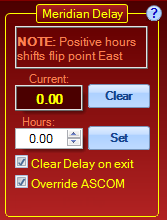Meridian Tab - Customizable Limits - Tracking Only
Use Homing/Limit Value for Both Tracking and Slewing
Introduction
The Meridian Limits are one of the most powerful and useful features of Astro-Physics mounts when used in conjunction with the Astro-Physics Command Center (APCC). They open up the possibility of imaging on both sides of the meridian WITHOUT wasting time on a pier flip at declinations where the scope will not strike the pier. The limits, when properly configured, allow you to track safely past the meridian up to the limits you set based on your unique instrument package. In addition, they allow you to begin an image ahead of the meridian by safely slewing you into a counterweight-up position to start an imaging series that can then simply continue through the meridian. However, like any powerful feature, you MUST understand how the meridian limits work. It is vital that you understand what they CANNOT do as well as understanding what they can do!
Warning: Please take special note of the following: •The Meridian Limits, are primarily tracking limits in the west, and counterweight-up slewing guides for APCC's advanced slew logic in the east. They will NOT prevent you from slewing into your pier with an incorrect slew, or from running into the pier with direction buttons. •DO NOT use any other method for setting a meridian delay while you are using the meridian limits. When properly configured, the APCC meridian tracking limit logic will maintain the correct meridian delay in the system. •Allow the "Counterweight Up Slews within: East Limits" feature (see Operation below) to safely slew your mount into a meridian advanced position east of the meridian. Do not try to "outsmart" the system and finagle this yourself. •We suggest that you do your Horizon limits before doing your meridian limits. |
Understanding East vs. West limits. People can get confused with the East and West limits. This is in part due to the conventions used in German Equatorial mounts regarding pier side. In APCC's Meridian Limits, East and West define where the scope is pointing. In both cases, the limits apply when the counterweights are up with the scope on the wrong side of the pier in a position that is not considered "normal". (Normal being with the counterweights down, but the scope on the other side of the pier.)
Think of West Limits as SAFETY LIMITS. These are the limits that protect you from tracking into the pier, and most people would consider them to be the most important. A normal scenario would be that you start pointing to a target in the east with the counterweight in the normal down orientation. Then, as you track the object across the sky, the telescope reaches and then crosses the meridian and the counterweight goes into an "up" orientation. These limits determine how far you can track past the meridian without getting into trouble.
Think of East Limits as OPPORTUNITY LIMITS. With an AP mount, you have the opportunity to start tracking an object that is in the east from a counterweight "up" orientation, and then tracking through the meridian into a normal counterweight "down" position to finish tracking on to your horizon. This allows you to avoid the need to flip at the meridian.
Operation
PulseGuide, the AP V2 ASCOM Driver, and the mount's keypad each have the ability to set a meridian delay which controls the flip point of the mount. APCC adds some powerful new capabilities. Three of these new features apply to West Meridian Limit points. The West limits come into play when a scope's counterweight is in the up position (scope under the mount) and the scope is pointing West of the meridian. This normally occurs when the scope is allowed to track past the meridian. The fourth feature below applies to east meridian limits and provides a unique and powerful tool for safely starting images in the east from the east side (counterweight up) using the meridian advance.
•Instead of just a single meridian limit for all declinations, you can configure an arbitrary number of different limits at different declinations. This is useful because at each declination there can be a different hour angle at which the telescope will touch the pier. In declination regions where the telescope can theoretically go the full 6 hours past in the west, the meridian limits can establish horizon tracking limits for the practical distance past the meridian where you can reasonably continue to work. Likewise, in the east, they can set the practical horizon ahead of the meridian where you can reasonably start an image.
•When a meridian tracking limit is reached, tracking can be automatically stopped; the scope can be "flipped"; the scope can be parked; or no action can be taken other than a warning.
•Meridian tracking limits can also be used to create a safe zone around your pier if it interferes with even reaching the zenith, similar in a way to the safe zone in the Astro-Physics GTO keypad. The keypad's safe zone, however, is a GoTo slew limit, rather than a tracking limit. Remember that an APCC Meridian Limits safe zone that does not allow the scope to reach the Meridian must be stopped or parked. It cannot be flipped.
•When east limits are properly configured and employed, slews to targets within the east limits will automatically be made using meridian advance and APCC's safety slew logic to place the system in a counterweight-up position with the scope on the east for uninterrupted imaging through the meridian. The safety slew logic ensures that all mount movement with the counterweight up is with the RA only. Using the East Limits, the scope can image through the meridian and on for another 6 hours before the telescope reaches the horizon. See: Counterweight Up Slews within: East Limits below.

The ability to work past the meridian into the west, or to start ahead of the meridian in the east has always been a hallmark of Astro-Physics mounts. Both the keypad and the earlier PulseGuide program provided the ability to work beyond the meridian. However, with both of these control methods, the user would want to be present at the mount for safety. APCC creates meridian limits that can allow the user to safely exceed the meridian without hovering over the mount to protect the scope and imaging equipment from a potential crash. Remotely controlled observatories can now also safely image through the meridian (where declination permits it).
Enable Meridian Tracking Limits: This check box enables the meridian tracking limit functionality allowing tracking to safely continue beyond the meridian until the west limit is reached..
Action when limit reached: This defines the action taken when the mount tracks into the West limit. The choices are to:
oStop tracking. The mount simply stops where it is and waits for user input.
oPark mount. Parks the scope at the park position defined on the Park tab,
o"Flip" scope, The mount will perform a safety slew into a CW down position and then a normal slew back to the target, but in the conventional CW down position.
oJust Warn. APCC will place a warning on the top of your screen to inform you that the limit has been exceeded. Use this option only if you are watching the scope! It can be handy if you start an image that will last just beyond the limit, but that you think will still be within your safety margin.
In their traditional role, the meridian limits just act as a safety stop when tracking and the East limits effectively are not used. However, you can elect to use the east limits to safely slew the mount into a counterweight-up position to maximize imaging time of a single target as it tracks past the meridian. To do that you would use this:
NOTE: The following two checkboxes should ONLY be checked if you are using your mount "hands on". At the present time, automation software has not been written to fully accommodate these features in APCC. Programs like ACP and CCDAutoPilot cannot yet take full advantage of these capabilities. This will require cooperative development between the respective software developers. DO NOT check these options if operating remotely via ACP or CCDAP! A Warning box will appear when these boxes are checked to help prevent problems. |
Limit to Meridian: Limits the Flip Offset to be at most set to the sky's real life meridian.
Flip Offset: This defines a period of time during which the mount can be "flipped" before the actual Meridian Limit is reached. This may be useful when using third party applications so they can perform a meridian flip before reaching the Meridian Limit, which may trigger tracking to stop or parking the mount.
Flip Offset Padding: This adds or subracts time (in minutes) to the Flip Offset value sent to Sequence Generator Pro.
NOTE: Limit to Meridian, Flip Offset, and Flip Offset Padding only apply when the mount pier side is West (pointing East with counterweight "down", or West with counterweight "up").
The Meridian Limit usually varies with declination. The Flip Offset adjusts the meridian flip point a number of minutes from the configured Meridian Limit at the current declination. If this option is enabled and the meridian flip point would be pushed past the actual sky meridian, the meridian flip point will be instead limited to the sky meridian.
Counterweight Up Slews within:
•East Limits: When pier side is East then slews to coordinates between the meridian and East limit values will result in the mount ending up in a counterweight-up position pointing East. This will allow the target to be tracked through the meridian into a conventional counterweight-down mode without needing to be flipped. This is the automated way to start your image ahead of the meridian, and is a classic technique for many experienced Astro-Physics imagers. Short focus slews to a nearby focus star will also not result in a pier flip, but they WILL result in a safety slew in most instances. This is a necessary safety feature.
•West Limits: When pier side is West then slews to coordinates between the meridian and West limit values will result in the scope ending up in a counterweight-up position pointing West. This will avoid a meridian flip until the West limit is reached. However, if the mount is already on the East side pointing West, and within the West limits, the mount will not flip. This can be considered a "dynamic meridian delay", because the delay automatically changes based on declination. The primary use of this feature is to facilitate small slews for focusing while the mount has tracked past the meridian without instigating a pier flip.
Time before limit reached: This is a countdown timer. It gives the time remaining until the meridian tracking limit is reached at the current Declination. It is only enabled when meridian tracking limits are enabled.
Starting with version 1.5.1.0 the clock time at which the limit will be reached is also displayed.
Send Limit to SGPro: If Sequence Generator Pro (SGPro) is running and declination changes, the current meridian delay value is sent to SGPro. SGPro can use that delay to determine how far before or after the meridian that a pier flip will occur. SGPro will only attempt to do the pier flip once the meridian delay value is reached.
Meridian Tracking Limits - Hour Angle/Meridian Inclination
The Meridian Inclination is the angle measured along the meridian line from the Southern horizon to the Northern horizon in the Northern hemisphere, and from the Northern horizon to the Southern horizon in the Southern hemisphere. Meridian Inclination = 0 at the horizon opposite your pole (ignoring the effects of refraction) and Meridian Inclination = 180 at the horizon below your pole. Use of Meridian Inclination gets around the ambiguity of some declination values underneath the pole compared to those above the pole. For example, in the northern hemisphere at 50 degrees latitude, 85 degrees declination meets the meridian at two positions, one above the north celestial pole, and one below the north celestial pole. The Celestial pole is always at Meridian Inclination = 180 - latitude. At this 50 degree latitude, the pole is at a meridian inclination of 180 - 50 = 130. And 85 degrees declination occurs at meridian inclinations of both 125 (above pole) and 135 (below pole).
Edit: Allows you to configure the East/West Meridian limits. Clicking will bring up the Meridian Tracking Limits Explorer.
Show East Limits: When checked, shows the East Limits.

Show West Limits: When checked, shows the West Limits.

Hour Angle Scale: Allows you to magnify the hour angle values.

Meridian Delay
The ability to advance or delay the meridian to avoid a meridian flip has been a hallmark of the Astro-Physics GTO system since its initial development. Starting with APCC and the Rev. "S" firmware in 2012, the method for employing this feature has been changed in the GTO Servo Control Box. The delay is no longer accomplished by "fooling" the clock in the servo. It is now an independent function with associated commands that does not change the mount's time.
Note: The earlier method employed by the keypad and PulseGuide will still work. APCC only uses the new method. The V2 ASCOM Driver can use either and will choose its method based on the firmware version it detects. The important thing to remember is to NOT mix methods! Do not set a meridian delay with APCC and then try to undo it with the keypad, or vice versa. |

Current: The current meridian delay as polled from the mount. Note how this value changes at different declinations if APCC's Meridian Limits are enabled. This is the manifestation of the "dynamic meridian delay" described earlier.
WARNING! Do not make manual meridian delay adjustments if you have activated meridian limits. Allow APCC to set and control the meridian delay. The Hours field and the Clear and Set buttons described below are intended for manual control without active limits. |
Clear: Clears the meridian delay back to zero.
Hours: The meridian delay value to use when Set is clicked. Positive values move the local meridian to the east for meridian advance. This allows you to start an image from the "wrong" side and then track through the meridian into a normal orientation without a flip. Negative values move the logical meridian to the west and allow you to "delay" the flip point of the mount.
Set: Sets the meridian delay to the value in the Hours field.
Clear Meridian Delay on Exit: This will restore the meridian delay to 0 when exiting so that the mount's flip point is not in an unexpected position. It is recommended that you keep this checked.
Override ASCOM: APCC will override the ASCOM Driver's meridian delay setting. This will allow the more precise meridian adjustments that are possible with APCC's Meridian Limits. If you have set good Meridian Limits in APCC, you should let it handle the meridian and keep this box checked so that an ASCOM client doesn't set an incorrect meridian delay value.
